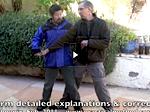It was not until I tried to follow the first of the essential videos of Master Chen when I saw the difference, and practically feel the changes in the body.
Precise instructions, every time!
After three years of practicing and learning through videos, the at first glance uncomprehensive terms of Taiji as described by Master Chen started making sense by following the videos which graciously offer to the student numerous practical ways to train. The research on Taiji terms also started from the website after looking for terms on the search bar and buying a few relative videos at a time.
Chen Style Taijiquan Practical Method, by Hong JunSheng and as it is passed on by Master Chen Zhonghua is a system based on the foundation exercises, in the same way like a building’s stability and design is based on it’s a foundation on the ground. The practice of foundations gradually carves the rough idea and step by step enriches the structure of the body by adding elements from the Taiji dimension.
It is important to note that all the required material is there, already on the human body, though in the beginning students soon understand that the body is not made of Taiji material. By putting training in action, the student understands that the independent body parts’ movements gradually form a structure, simply as saying they start to work together. These parts act in the same way as the parts or material that form a machine, a train, a house, etc.
During the great workshop in Vienna in 2017, Master Chen explained that Practical Method as taught by Hong is all about consistency and quality. As time and effort are spent in practice the way quality is understood and applied on the body changes day by day. In this way, changes can be observed and felt by the student.
We could also say that Taiji is about contact. For those who like watching the videos, Master Chen pretty often as much as all the time speaks about touch and contact… From the point when the students touch him as he demonstrates the principle of “Truly Don’t move” to the martial art applications.
The point of contact is physical and it needs to be made not to move. Then it needs a line or a point of reference, in order to create a rail and later on a vector move, by connecting the hand to the floor.
Taiji is about relationships.
Relationship of yin and yang. If we put it in our everyday life scope of view among all our everyday contacts, or visits in Master Chen’s workshops, when learning to enter the door of Taiji, we simply meet other people who are seeking for the same goal. Those are Taiji friends, or friends practicing Taiji.
Nevertheless, in life the environment we live matters as well, as a clean environment is better to be in contact with and it constantly needs to be maintained.
Practical method system trains the body first. It all starts from the dot on the wall, the tile hand, the 7-inch knife, opening up the shoulders and it moves on… to nine count circles. When putting a restriction on the body, it surely feels awful. But according to PM Taiji practice, it is the only way to train the body and at the same time have a taste of the principles explained and applied by Master Chen during his workshops.
Chen Style Taijiquan Practical Method is a system that guides the student to the realm of Taiji through physical contact and the goal as in every art is to look for and gain a better understanding of the world around us.
Practical Method Taiji practice is built on this system of training, urging the students to start using everyday material, make devices and then train with them. The only thing PM students need to do is to follow the clear instructions offered by Master Chen and then gradually add restrictions so that certain body parts do not move in practice! In this way, learning is a lot safer and time-saving.
In the end, the student should not forget that it is the Yilu form that makes the practice real, just like laying the rail tracks of a train, as Hong Junsheng described.
On 12/01/2019 there was a meeting on Skype among the PM students living in Europe. It was nice to see some fellow practitioners and friends on camera and being able to discuss updates, practice, and future joint events. The next meeting is on Thursday, 24/01/2019 at 20:30 Central European Time, for everyone that feels to join.


